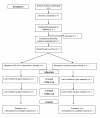Improving health-related fitness in children: the Fit-4-Fun randomized controlled trial study protocol
- PMID: 22142435
- PMCID: PMC3245453
- DOI: 10.1186/1471-2458-11-902
Improving health-related fitness in children: the Fit-4-Fun randomized controlled trial study protocol
Abstract
Background: Declining levels of physical fitness in children are linked to an increased risk of developing poor physical and mental health. Physical activity programs for children that involve regular high intensity physical activity, along with muscle and bone strengthening activities, have been identified by the World Health Organisation as a key strategy to reduce the escalating burden of ill health caused by non-communicable diseases. This paper reports the rationale and methods for a school-based intervention designed to improve physical fitness and physical activity levels of Grades 5 and 6 primary school children.
Methods/design: Fit-4-Fun is an 8-week multi-component school-based health-related fitness education intervention and will be evaluated using a group randomized controlled trial. Primary schools from the Hunter Region in NSW, Australia, will be invited to participate in the program in 2011 with a target sample size of 128 primary schools children (age 10-13). The Fit-4-Fun program is theoretically grounded and will be implemented applying the Health Promoting Schools framework. Students will participate in weekly curriculum-based health and physical education lessons, daily break-time physical activities during recess and lunch, and will complete an 8-week (3 × per week) home activity program with their parents and/or family members. A battery of six health-related fitness assessments, four days of pedometery-assessed physical activity and a questionnaire, will be administered at baseline, immediate post-intervention (2-months) and at 6-months (from baseline) to determine intervention effects. Details of the methodological aspects of recruitment, inclusion criteria, randomization, intervention program, assessments, process evaluation and statistical analyses are described.
Discussion: The Fit-4-Fun program is an innovative school-based intervention targeting fitness improvements in primary school children. The program will involve a range of evidence-based behaviour change strategies to promote and support physical activity of adequate intensity, duration and type, needed to improve health-related fitness.
Trial registration no: Australia and New Zealand Clinical Trials Register (ANZCTR): ACTRN12611000976987.
Figures
Similar articles
-
Scaling-up an efficacious school-based physical activity intervention: Study protocol for the 'Internet-based Professional Learning to help teachers support Activity in Youth' (iPLAY) cluster randomized controlled trial and scale-up implementation evaluation.BMC Public Health. 2016 Aug 24;16(1):873. doi: 10.1186/s12889-016-3243-2. BMC Public Health. 2016. PMID: 27557641 Free PMC article. Clinical Trial.
-
A school-based physical activity program to improve health and fitness in children aged 6-13 years ("Kinder-Sportstudie KISS"): study design of a randomized controlled trial [ISRCTN15360785].BMC Public Health. 2006 Jun 6;6:147. doi: 10.1186/1471-2458-6-147. BMC Public Health. 2006. PMID: 16756652 Free PMC article.
-
Improving the fitness and physical activity levels of primary school children: results of the Fit-4-Fun group randomized controlled trial.Prev Med. 2013 Jan;56(1):12-9. doi: 10.1016/j.ypmed.2012.10.019. Epub 2012 Oct 26. Prev Med. 2013. PMID: 23107669 Clinical Trial.
-
School-Based Intervention Programs for Preventing Obesity and Promoting Physical Activity and Fitness: A Systematic Review.Int J Environ Res Public Health. 2020 Jan 3;17(1):347. doi: 10.3390/ijerph17010347. Int J Environ Res Public Health. 2020. PMID: 31947891 Free PMC article.
-
Effect of school-based interventions on physical activity and fitness in children and adolescents: a review of reviews and systematic update.Br J Sports Med. 2011 Sep;45(11):923-30. doi: 10.1136/bjsports-2011-090186. Br J Sports Med. 2011. PMID: 21836176 Free PMC article. Review.
Cited by
-
Strategies for enhancing the implementation of school-based policies or practices targeting risk factors for chronic disease.Cochrane Database Syst Rev. 2017 Nov 29;11(11):CD011677. doi: 10.1002/14651858.CD011677.pub2. Cochrane Database Syst Rev. 2017. Update in: Cochrane Database Syst Rev. 2022 Aug 29;8:CD011677. doi: 10.1002/14651858.CD011677.pub3. PMID: 29185627 Free PMC article. Updated.
-
Social support from teachers mediates physical activity behavior change in children participating in the Fit-4-Fun intervention.Int J Behav Nutr Phys Act. 2013 May 28;10:68. doi: 10.1186/1479-5868-10-68. Int J Behav Nutr Phys Act. 2013. PMID: 23714651 Free PMC article. Clinical Trial.
-
Recess Activity and General Health Status among Iranian Elementary Schools' Pupils.Health Promot Perspect. 2013 Jun 30;3(1):45-54. doi: 10.5681/hpp.2013.006. eCollection 2013. Health Promot Perspect. 2013. PMID: 24688952 Free PMC article.
-
Evaluation of Social Impact Within Primary School Health Promotion: A Systematic Review.J Sch Health. 2022 Aug;92(8):739-764. doi: 10.1111/josh.13160. Epub 2022 Apr 1. J Sch Health. 2022. PMID: 35365879 Free PMC article.
-
The WHO Health Promoting School framework for improving the health and well-being of students and their academic achievement.Cochrane Database Syst Rev. 2014 Apr 16;2014(4):CD008958. doi: 10.1002/14651858.CD008958.pub2. Cochrane Database Syst Rev. 2014. PMID: 24737131 Free PMC article.
References
-
- Tomkinson GR, Oliver S. Secular changes in pediatric aerobic fitness test performance: the global picture. Medicine and Sports Science. 2007;50:46–68. - PubMed
-
- Tomkinson GR, Olds TS. Secular changes in aerobic fitness test performance of Australasian children and adolescents in: Pediatric Fitness. Secular trends and Geographic Variability. Medicine & Sports Science. 2007;50:168–182. - PubMed
-
- Malina RM. Tracking of physical activity and physical fitness across the lifespan. Research Quarterly for Exercise and Sport. 1996;67:S48–57. - PubMed
Publication types
MeSH terms
LinkOut - more resources
Full Text Sources
Medical


